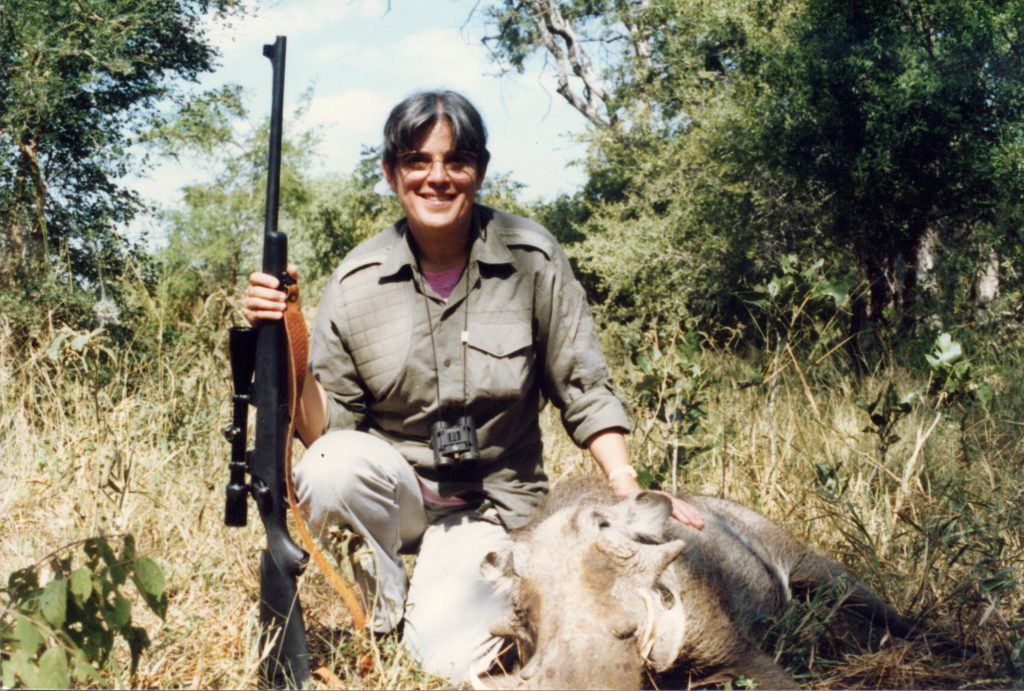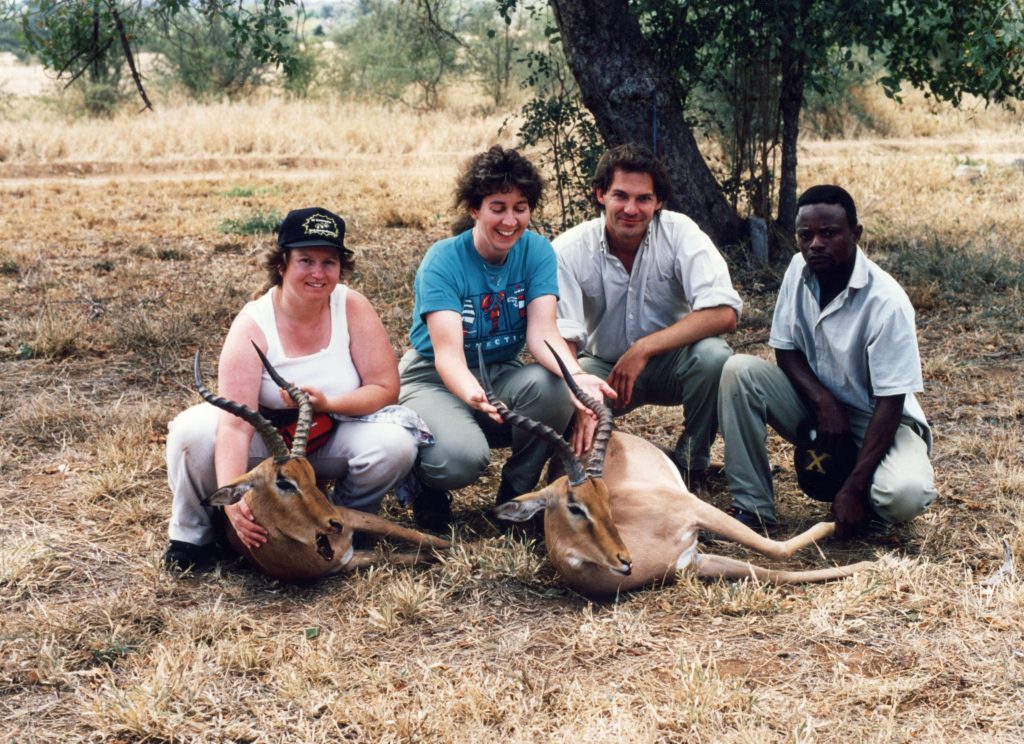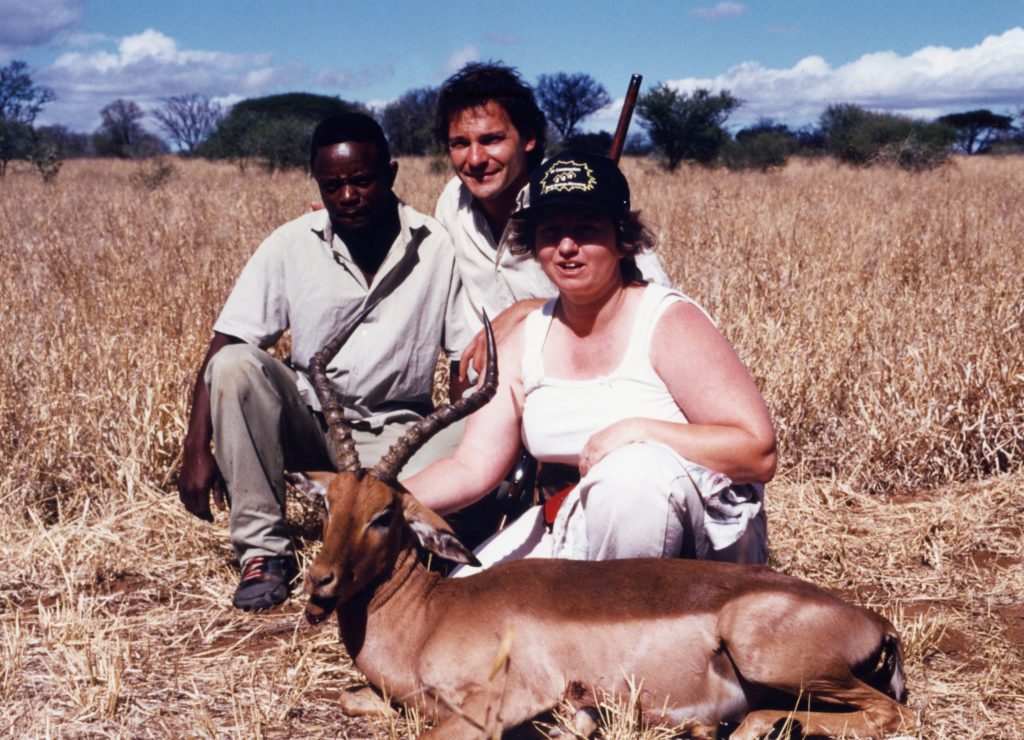Becky Johnston and I followed Professional Hunter Chris Steyn up out of the river swamp near Landela Lodge. A large herd of impala ran ahead of us onto the veldt. At the very end of the herd a nice ram hesitated, and Chris said to Becky, “Shoot!” She did; the ram ran back into the swamp and disappeared. Though neither Chris nor I thought the ram had been hit, we walked to where he had been standing and searched for any trace of blood.

Fifteen minutes later Chris found a single red drop on a blade of grass. After a long slow stalk along the river he spotted the ram lying down, and anchored it with a shot to the neck. It wasn’t a huge ram, but it was nice, and would make a pretty mount.
Unless you’ve been living under a rock, you already know that the number of women hunters has increased dramatically in the last fifteen years. We’re finally getting some younger women into the field as well, as many of the outdoorsy 20-somethings have discovered the sense of accomplishment that goes with taking an animal from the field to the table.
That enthusiasm for the hunt includes taking trips to exotic locations to hunt. Until the last few years only a few women went to Africa to hunt; today, if a male hunter is planning a trip and his significant has anything to say, it’s likely to be “I want to go too!”
Fifteen years ago I had the privilege of accompanying two women on their first African hunt. Both of these women were adventurous and not afraid to try something different, and both were from hunting families who supported their desire to take a trip to Africa.
The hunt came about because of a conversation I had with Rocco Gioia, owner of Caskett’s Ranch, near Hoedspruit, South Africa. After a successful hunt with him, I had asked him how he’d feel about me coming back and bringing a hunting party of women to the ranch. Though he seemed a bit skeptical, he agreed to give a women’s hunt a try, and even offered a special rate for that first hunt.
The first person to commit to the hunt was Debbie Holland, a schoolteacher from Levi, Utah. She confided that when her husband heard of the opportunity, he said that she must go. He was so insistent, in fact, that he was willing for them to take out a small loan to finance her trip.
For a while, I thought Debbie would be the only hunter who went. Then I received a letter from Becky Johnston, whose husband Terry had seen mention of the hunt in a letter to the editor of an outdoor magazine. She wrote that she worked at K-Mart, and figured she probably couldn’t afford to go, but she wanted to know all the details.
I called Becky and told her as much as I could about the hunt, including Rocco’s special rate. Then I asked if she’d like go.
She had only one question. “When do we leave?”
I had my second hunter.
One of the first questions both Debbie and Becky asked was “Do I have to shoot a big gun?” Debbie wanted to shoot her .270 with a 150-grain Barnes X-bullet in a factory load from PMC/El Dorado; the largest animal she would try for would be a kudu. That would give her 2150 foot-pounds of energy at 100 yards, or 1897 at 200 yards, which was farther than either she or Becky was likely to shoot.
Becky preferred to shoot a 180-grain Winchester Silvertip in her .30-06; her largest quarry would be a gemsbok. That would generate 2436 foot-pounds of energy at 100 yards; at 200, it would still be 2023. Although neither of those calibers is suitable for large or dangerous game, these women were on the forefront of a trend that is becoming move common today, as an increasing number of hunters are using smaller calibers for plains game. I checked with Rocco, and he felt comfortable about their choices. I decided to take both my .25-’06 and my .375 H&H Magnum.
With the .25-06 I’d be shooting the 100-grain hand loaded Nosler Ballistic Tips I’d been using for southern whitetails, which generated 2055 foot-pounds of energy at 100 yards and 1740 at 200 yards. If I stuck to deer-sized and smaller animals with the .25-’06 I should be all right; I’d use the .375 for anything larger.
Caskett’s Ranch, where we would be hunting, was at the edge of Kruger Park in the Eastern Transvaal region of South Africa. Much of that area consists of dryland thornveldt, but the Klaserie River runs through it, and provides a river swamp with plenty of habitat for bushbuck. Debbie and Becky would do some riding around and spotting game, but most of their hunting would be on foot or sitting at waterholes.
I reached Caskett’s Ranch several days before Debbie and Becky arrived in South Africa. I wanted to hunt a really big warthog, and a couple of the small things, preferably duikers. I also wanted a blesbok, but since the leopards ate all the blesbok at Caskett’s, I’d have to go elsewhere for that before Becky and Debbie arrived.
Rocco sent me down to J. “Shorty” Durand’s ranch in the Free State with Professional Hunter Andrew Hogg. The hunting at Shorty’s was considerably different from that at Caskett’s Ranch. Up at Caskett’s the bush is fairly dense, which provides both the hunter and the hunted with cover. A long stalk on foot usually is the norm. But in the Free State the habitat is more grassy and open; consequently both people and animals can see much farther, and the game is wild and wary as a result. Almost all shooting is done from a vehicle, because that’s the only way a hunter can get close enough for a shot. Even at that, it’s a challenge. We’re talking long shots here; a 300-yard shot wasn’t uncommon.
As we drove around, I saw a lot of game. Many of the animals were common species: lots of blesbok and springbok, and a huge herd of gemsbok, but few impala. I saw some oddities, too, such as white blesbok and black springbok.
A huge mixed herd of animals milled about together, blesbok, gemsbok, red hartebeest and zebra. We stirred them around a little with the vehicle and the blesbok separated from the rest. Twice they stopped less than 200 yards away and I got in position on a nice ram. But the first time another animal was standing behind the one I wanted, and the second time a branch hung right in front of his shoulder.

They started off again and we followed. Most of the herd crossed the road in front of us and the driver went hard after them, driving right through the herd. For a long moment I though the last few animals were going to leap into and over us in their determination to stay with the herd. Then the last five turned away from the road; we had successfully separated them from the rest.
From that point on the hunt was fairly straightforward. We followed the five animals—three red blesbok and two white—around until we got them in an open place about 85 yards away. I choose the biggest red ram, centered the crosshairs on his shoulder and squeezed the trigger. He dropped in his tracks.
When I got a good look at him I could see that the bullet had broken his spine mid-way of his back. Though it was a good shot, it was not the one I had chosen. Since I had had a steady rest, and I’m normally an accurate shot, I suspected the riflescope had gotten bumped. A subsequent trip to the range at Caskett’s proved my suspicion. Though I had checked the rifle when I first arrived in Africa, all the riding around on the veldt had caused the zero to shift high and to the left.

A few days later, Debbie and Becky arrived. Before they ever got into the field at Caskett’s, I had a feeling that hunting with them would be interesting. The first night at dinner Debbie told us that when they got to the airport in Johannesburg, Becky’s luggage didn’t appear. After they had waited almost an hour, baggage handlers finally found her suitcase and gun case at the very back of the baggage compartment.
Then at Customs, Debbie couldn’t get her gun case open. After struggling with it, she turned to Becky and said, “If there were three of us, we’d be the Three Stooges.” Becky replied, “Just wait a while. Maybe there will be.” All of us at the table nearly fell out of our chairs laughing. I couldn’t tell if I was Larry, Moe or Curly.
The next afternoon, Rocco took Debbie out for a ride, to get her acquainted with the ranch and maybe to stalk an animal. When they came back a couple of hours later,
Debbie was rattled. She said that while they were driving Rocco saw an animal, stopped the bakkie, and said, “Get out and shoot that.”
“What is it? It’s not on my list of animals,” she replied.
“I don’t care. I want you to have it. Shoot it!” he told her. So she did.
Both she and her .270 performed flawlessly, and she dropped a lovely bushbuck ram right where he stood. Even before I saw him, I was envious. A bushbuck is a notoriously hard animal to get; they’re cautious and wary and hide in the densest river swamps they can find. To get one on your first trip is remarkable; to get one on your very first afternoon of hunting is unheard of. To make things even better, Debbie’s ram was absolutely perfect. It didn’t have so much as a nick in either one of its ears from fighting.
For the next two days Debbie walked around saying, “But it wasn’t on my list. I wasn’t supposed to shoot it.” Only after close to a dozen people had said, “You shot what? On your first afternoon hunting??!” did she realize what incredibly good fortune she had had.
But after that, both Debbie’s and Becky’s luck seemed to run out. Rocco and Debbie couldn’t get on a kudu, and Becky couldn’t get even an impala. Professional Hunter Chris Steyn took Becky on long walks for three consecutive days without her getting a single animal.
On the fourth day, Chris and Becky and I walked up her impala. Then when we got back to the lodge with Becky’s ram, we found that Debbie also had gotten an impala while hunting with Rocco. We thought their luck had changed.
But the next two days were just frustration. Neither Rocco nor Chris could get Debbie on a kudu, or Becky on anything. Becky had decided against trying to take a gemsbok, since that would mean a trip down to Shorty’s; she was going to try for a waterbuck instead.
On the last day of the hunt, Rocco sent Becky and Debbie to a neighboring ranch with a different Professional Hunter to see if they could get at least a kudu for Debbie there. Chris took me to yet another ranch for a day of bowhunting, where I sat and worried about Becky and Debbie all day.
I need not have been concerned. When I got back to the ranch at the end of the day and called out to the two of them, they greeted me with shrieks of excitement. Not only had Debbie taken her kudu, she had gotten a huge warthog and a big waterbuck as well. Becky was equally ecstatic. She had killed a very nice waterbuck, one even bigger than Debbie’s.
That night I raised a glass of wine in a toast to both of them, and to Rocco. The three of them had proven my point: women can go to Africa on safari, and don’t have to spend a fortune or shoot a big-bore rifle to do it.
After Debbie and Becky left, I spent a few more days in Africa, at Songimvelo Game Reserve with some friends of mine. Though Songimvelo allowed hunting, the philosophy there was quite different than on a commercial ranch.
Since the Swazi people who lived around the Reserve gave up part of their land to create it, when they needed meat for the pot they received animals hunters killed.
While I was there, they needed meat. That meant I got a chance to hunt another blesbok. Hannes Marais, an anti-poaching officer and a good friend of mine, took me out. We drove into a little valley where we could see seven animals spread out below us, some standing, some lying down.
He picked out a nice big ewe, old enough, he said, to be past reproductive age. I made a short stalk to within perhaps 125 yards, sat down, took a good rest, and shot.
It should have been simple. She should have gone down in just a few yards. I knew I had hit her well in the heart/lung area; I’d chosen that instead of a shoulder shot to keep from ruining meat. All seven of the blesbok ran, and the ewe showed no sign of having been hit. But she ran behind the others, sort of by herself.
The ewe went up the hill opposite us and we followed, so we were in the valley.
“Shoot it again,” Hannes said. Then, “Wait. It feels bad,” as she lay down.
We started toward her. She got up and walked over the crest of the hill. I couldn’t quite get on her to take another shot.
Hannes sent the game scout who was with us over the hill far to our left. In theory, the ewe should have seen him and popped back over to our side. But nothing happened.
Finally we walked over ourselves. The game scout was way down in the next valley, and he motioned to us that the blesbok was just a little down from us.
We started down and almost walked over her. She jumped up and trotted into the thorn trees. But she was moving toward the game scout, and I wasn’t about to risk a shot under those conditions. Then Hannes pointed him out to me; he had moved up the hill so he was more or less behind us, well out of any danger from my shot. I took a quick, mid-body shot on the ewe at about 75 yards. She walked a little farther and lay down. Though she was still and made no more attempts to get up, she continued to breathe for several more minutes.
When we examined her, we could see that my first shot had been perfectly placed. It went right through the lungs, just a little above the heart. It was a shot that would have flattened a whitetail. But on the blesbok, the bullet had gone through the ribcage and lodged just under the skin without putting her down.
The other animals I was to take were quite a bit larger than the blesbok, so I switched to the .375. After fairly routine stalks—if anything in Africa ever can be called routine!—I took a zebra stallion and a nice waterbuck. Subsequent measurements confirmed that my waterbuck–which I took on my last day in Africa–was the largest one taken at Songimvelo until that time. It was a small fact which pleased Hannes greatly.

